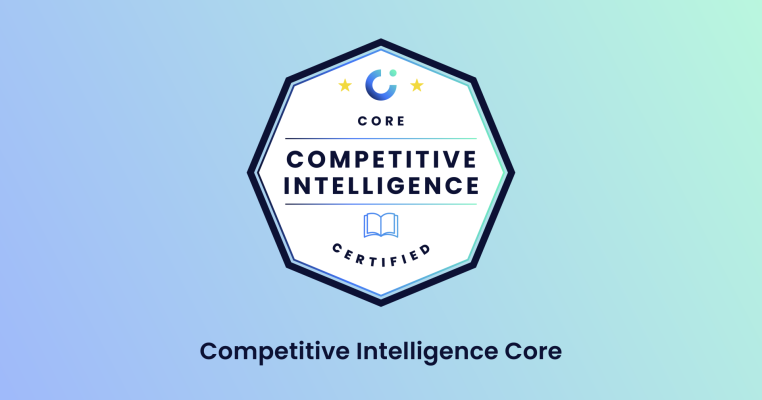Does your competitive intelligence (CI) function feel like an afterthought, disconnected from your company's core strategic objectives?
If so, you're not alone – a lot of CI teams struggle to demonstrate their value, and to impact key business decisions.
The good news is it doesn't have to be this way. By aligning your CI efforts with company goals from the get-go, you can transform competitive insights from a nice-to-have into the lifeblood of your organization.
This article outlines nine practical tips for aligning CI with your company's goals and using it to shape strategy and planning across the organization. From getting clear on the company vision to streamlining intelligence delivery, you'll learn how to position your CI function as an indispensable driver of business growth and competitive advantage.
The path won't be easy, but the payoff for getting CI alignment right is immense. So, let’s get to it.
1) Sit down with company leadership
We get it – your executives are busy. However, if you can’t sit down with them to talk about their strategic goals and vision for the company’s future, how will you know where to focus your efforts?
If you're at a smaller startup, cornering your CEO for a quick chat should be pretty straightforward. However, if you’re at a larger enterprise where you don’t bump into company leaders every day, you might need to try a different approach. Why not set up a short meeting and shoot them an email like the one below?
Hey [CEO's name],
I just wanted to touch base about integrating our competitive intelligence with our company goals. I think aligning our CI strategy with our broader objectives could give us a real edge in the market.
I’ve grabbed 15 mins on your calendar for next week – feel free to move it to best suit your schedule.
Looking forward to it!
[Your name]
This might seem like a bold tactic, but that’s the point! Remember: Fortune favors the bold.
2) Go on a listening tour
Whether you’re building a CI function from scratch, or revitalizing an existing CI program, you need to understand how each of your internal customers contributes to company goals before you can support their work with tailored competitive insights.
As August Jackson, Senior Director of Market and Competitive Intelligence at Deltek puts it:
“Successful competitive intelligence teams align their key performance indicators with the KPIs of the stakeholders that they're trying to support.”
To this end, David D’Aprile, VP of Global Product Marketing at Onapsis, recommends taking a listening tour.
As he says:
“You can even shadow your sales reps. This is going to help you understand who your stakeholders are, what has and hasn’t been working, and how pitching, trap-setting, and objection-handling are being done. This listening phase is essential for understanding the current state of affairs.”
3) Identify and fill key intelligence gaps
Whether your company is B2B or B2C, chances are that product, sales, and executive teams are already keeping half an eye on the competition. There's no value in trying to duplicate or compete with their existing workstreams and responsibilities.
Instead, you should aim to identify the key competitive and market intelligence gaps across the organization. Use your expertise to fill those voids with insights that elevate the entire company's decision-making.
For example, you may find teams struggling with:
- Ad-hoc, manual competitive analysis that doesn't scale or provide consistently reliable intelligence.
- Lack of data-driven market assessments and win/loss analysis, forcing teams to rely on gut instinct.
The more you can systematically identify and meet these types of intelligence needs, the more indispensable your role will be in strategic planning and execution. It builds trust that will win you a seat at the table for major initiatives impacting the business.
4) Translate insights into actionable recommendations
It’s not enough to gather and share cold hard facts on your competitors – you need to transform this intel into concrete recommendations that’ll drive strategic priorities across the organization.
Translate your findings into clear implications for product roadmaps and competitive positioning. Spell out how this intelligence will help them differentiate and outcompete, as well as how it should shape future feature development.
5) Embed CI Into strategic discussions
When major product initiatives are being planned, it's a great idea to step back and consider how different scenarios might impact important metrics like revenue, market share, and customer acquisition. By bringing a data-driven competitive perspective into strategic discussions, you can make sure you're setting the business up for success.
For example, let's say your company is revamping its pricing model. A great way to make an informed decision is by conducting a thorough competitive pricing analysis. With these insights, you can then shape your new pricing strategy to better meet the needs of your customers.
6) Aspire for game-changing impact
As your competitive intelligence capabilities mature, you’ll want to start actively exploring how you can uncover game-changing insights that elevate your company's products and initiatives to best-in-class.
For major upcoming launches or innovations, develop “hero” scenarios backed by your research and modeling. Lay out a vision of how this offering could redefine the market and customer experience if shaped by your competitive recommendations. Inspire stakeholders to dream bigger based on the opportunities you've identified through CI.
7) Strive for seamless CI delivery
To drive impact with your competitive insights, it’s vital to establish consistent standards for how that intelligence gets packaged, distributed, and embedded across the organization. The aim is to provide tailored and actionable CI to stakeholders in a reliable and streamlined way.
We recommend focusing on these three key areas:
- Reliable cadence: Establish a predictable calendar for delivering up-to-date competitive intelligence outputs. Whether weekly competitor intelligence newsletters, monthly market trackers, or reports aligned to annual planning, stakeholders need clarity on when to expect new insights that’ll support their priorities.
- Enterprise-wide relevance: Although each team or region may have unique CI needs, look for ways to bundle core deliverables that provide valuable insights applicable across multiple groups.
- Seamless experience: Make it frictionless for stakeholders to access and digest competitive intelligence by integrating CI directly into collaboration tools, knowledge repositories, and workflows they already use.
When you standardize your delivery of CI based on these areas, you’ll help everyone to make the most of your competitive intelligence and use it to drive strategic impact.
8) Trade instant gratification for long-term value
As you launch or revamp your CI function, your stakeholders might be expecting quick wins. While getting a few of these under your belt is a great way to prove the value of your CI function, it’s important not to lose sight of overarching company objectives.
If you can, aim for an 80/20 split between the time you dedicate to long-term strategic contributions and the time you spend on short-term gains. This approach will lay the groundwork for sustainable strategic impact.
9) Manage expectations
When you're working on integrating CI with broader strategy and planning processes, it's important to be transparent about the trade-offs and priorities involved. Don't hesitate to explain why some tasks are more urgent than others when it comes to achieving your larger goals. Clear communication helps everyone stay on the same page and avoid misunderstandings.
Key takeaways
Aligning your CI function with company-level objectives takes a lot of work upfront, but the payoff is more than worth it. So, let’s recap the key takeaways that’ll make CI an indispensable driver of your organization's success:
🌟 Start to foster executive buy-in by sitting down with leadership to understand their strategic vision and goals for the company. This ensures your CI efforts are laser-focused on supporting the priorities that matter most.
👂 Go on a listening tour across teams to understand their roles, pain points, and how they currently approach competitive analysis. This context allows you to identify and fill key intelligence gaps.
🎯 Push beyond just sharing data – translate your competitive insights into clear, actionable recommendations that directly inform strategic decisions around product roadmaps, go-to-market strategy, and more.
🧭 Aspire for game-changing impact by developing research-backed "hero" scenarios that inspire stakeholders to dream bigger about potential market opportunities and innovations.
📦 Establish consistent standards for packaging and delivering CI, striking the right cadence, relevance across teams, and seamless integration into existing workflows.
🔭 Be upfront about managing stakeholder expectations – prioritizing long-term strategic impact over short-term wins.
💪 Be persistent! Aligning CI with big strategic objectives isn’t easy, but it unlocks faster growth, more confident decision-making, and the power to outmaneuver competitors.
Give yourself an unfair advantage
Our newest competitive intelligence course lifts the lid on the frameworks and processes experts use to deliver impactful intel with confidence.
You can expect:
- A 100% self-paced and online course packed with competitive wisdom so you can stop worrying and start winning.
- Bonus features from established competitive professionals to give you an unfair advantage.
- 6 downloadable, customizable templates and frameworks that make analysis a cinch.

Competitive Intelligence: Core
We'll show you how to:
- 👑 Lead development of your org’s all-important competitive positioning.
- 🦾 Master CI’s essentials, including its most powerful research techniques.
- 🚀 Arm sales and customer success with intel to skyrocket win rates and turn down churn.
- 🧠 Offer leaders critical intel that informs their decision-making and strategy.
- 📈 Elevate CI’s role within your org to ensure career progression.




.png?v=09cf73b4b5)